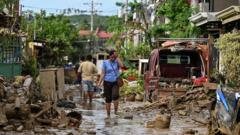Global warming is forcing Earth's systems toward 'doom loop' tipping points. Can we avoid them?
NegativeScience

Earth is facing critical climate change tipping points that could lead to irreversible damage, often referred to as 'doom loops.' This situation is alarming because it highlights the urgent need for action to mitigate climate change and prevent catastrophic outcomes for our planet and future generations.
— via World Pulse Now AI Editorial System





